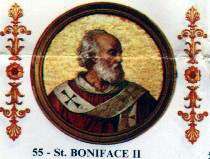Pope Boniface II
| Pope Boniface II | |
|---|---|
 | |
| Papacy began | 17 September 530 |
| Papacy ended | 17 October 532 |
| Predecessor | Felix IV |
| Successor | John II |
| Personal details | |
| Born | Rome, Italy |
| Died | 17 October 532 |
| Other popes named Boniface | |
Pope Boniface II (Latin: Bonifatius II; died 17 October 532) was the first Germanic pope. He reigned from 17 September 530 until his death in 532.[1] He was born an Ostrogoth.
Boniface was chosen by his predecessor, Pope Felix IV, who had been a strong adherent of the Arian king, and was never elected. He was later elected, largely due to the influence of the Gothic king Athalaric.[2] For a time, Boniface served as pope in competition with Dioscorus, who had been elected by most of the priests of Rome. Boniface and Dioscorus were both consecrated in Rome on 22 September 530, but Dioscurus died only twenty-two days later.[1]
Boniface II's most notable act was confirming the decisions of the Council of Orange, teaching that grace is always necessary to obtain salvation.[3][2] Boniface was buried in St. Peter's on 17 October 532.[1]
Roman Calendar
Boniface changed the numbering of the years in the Julian Calendar from Ab Urbe Condita to Anno Domini.
References
- 1 2 3
 Peterson, John Bertram (1913). "Pope Boniface II". In Herbermann, Charles. Catholic Encyclopedia. New York: Robert Appleton Company.
Peterson, John Bertram (1913). "Pope Boniface II". In Herbermann, Charles. Catholic Encyclopedia. New York: Robert Appleton Company. - 1 2 Cline, Austin. "Today in History: 17 September 530: Election of Pope Boniface II, First German Ever Elected to Papacy". Skepticism - Skeptical Notes on Politics, Culture, Religion. Retrieved 2017-03-16.
- ↑ "Pope Boniface II". Catholic Encyclopedia. Retrieved 2017-03-17.
External links
| Wikimedia Commons has media related to Bonifacius II. |
| Wikisource has the text of the 1913 Catholic Encyclopedia article Pope Boniface II. |
| Catholic Church titles | ||
|---|---|---|
| Preceded by Felix IV |
Pope 530–532 |
Succeeded by John II |

